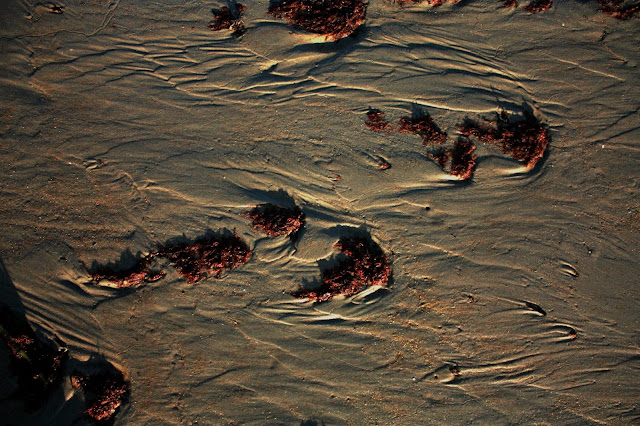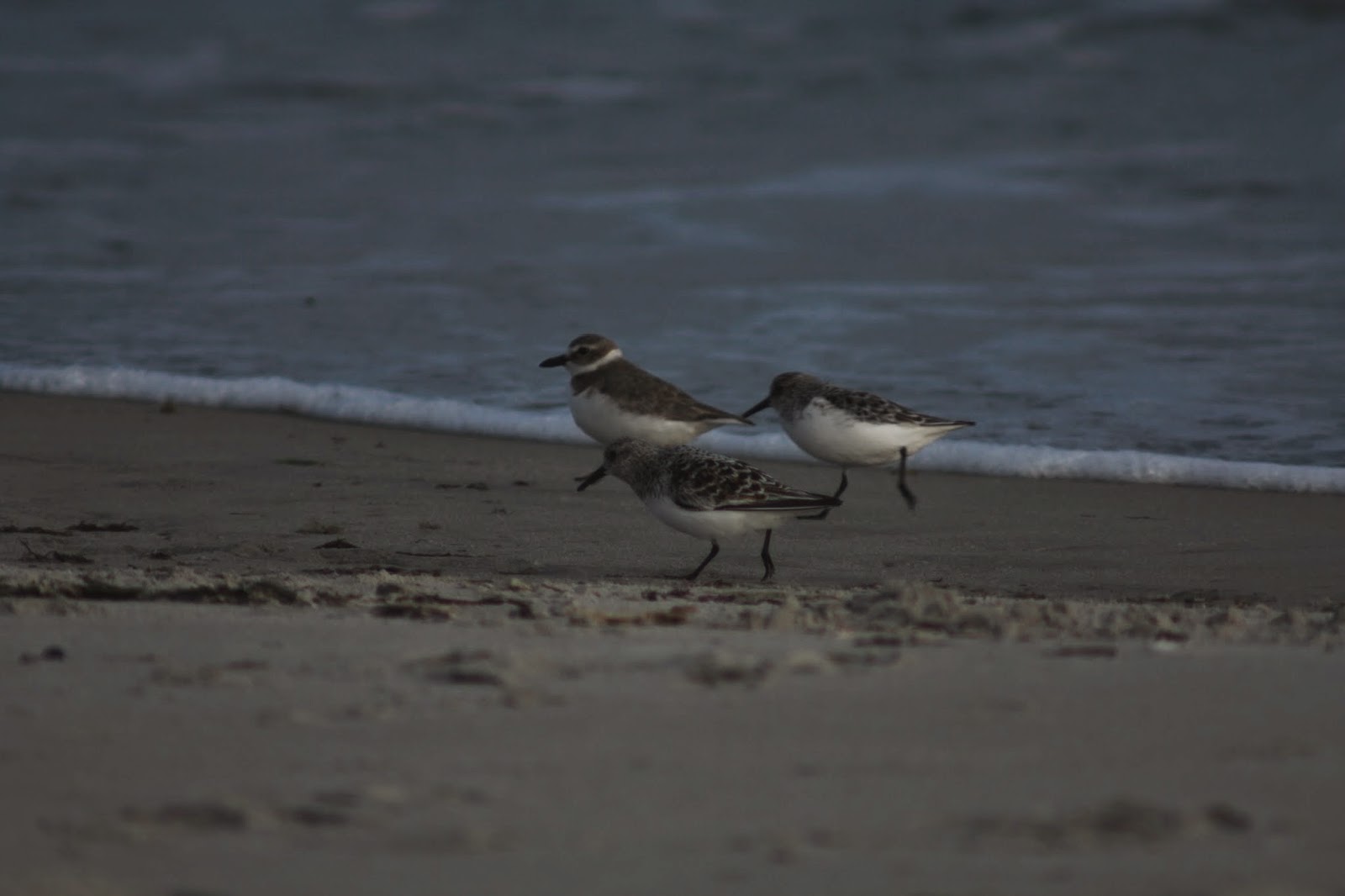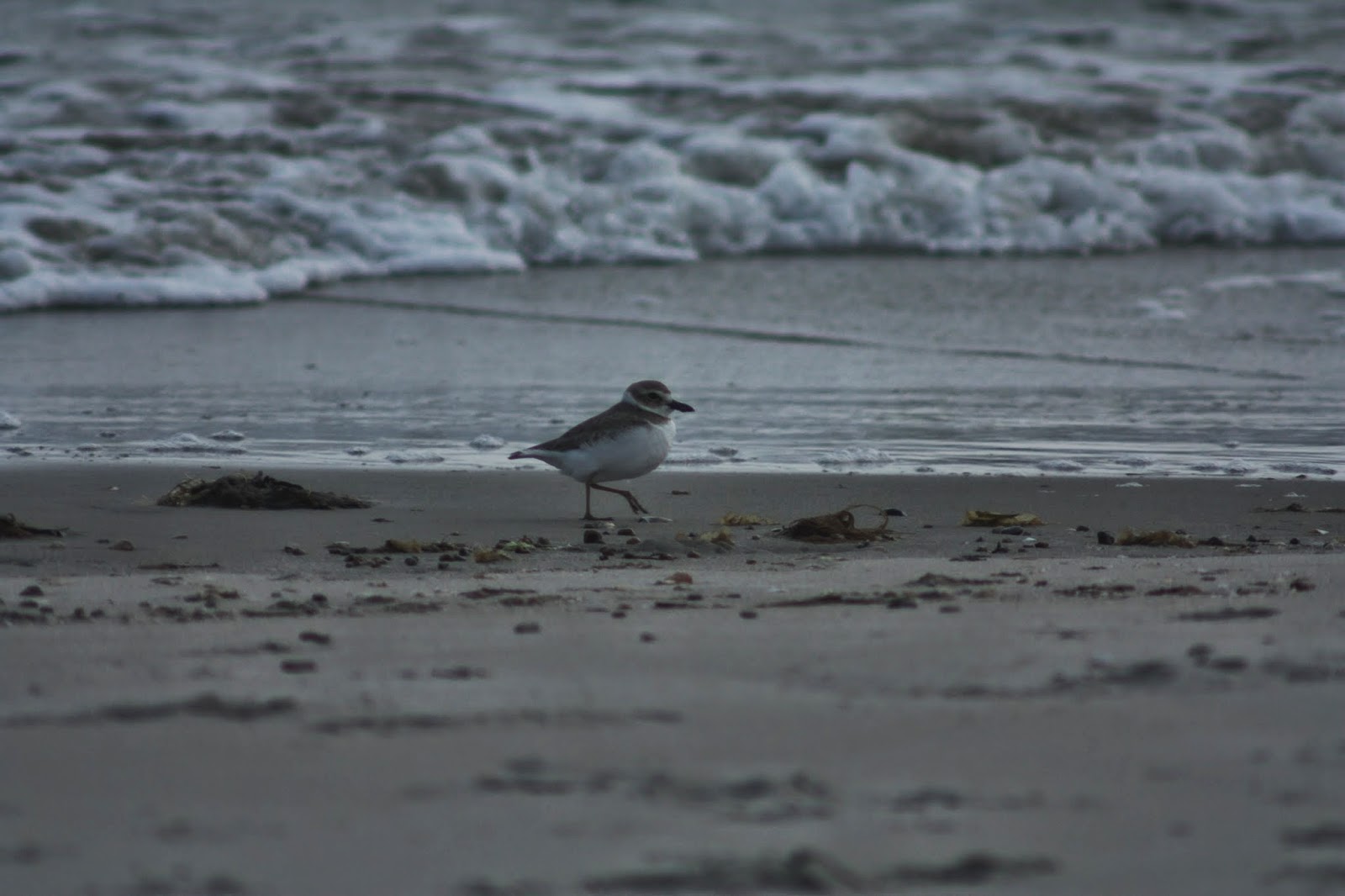Migrant Shorebirds and Mole Crabs - an interesting system at Horseneck Beach State Reservation,
Westport, MA
NEWEST POSTS AT BOTTOM OF PAGE (other than a May, 2014 Wilson's Plover, no new additions as of June 2014).
Horseneck Beach State Reservation, Westport, MA offers a variety of birding opportunities, and my previous blog and next blog post address migrants at Gooseberry Neck (spring and fall, respectively). This blog post offers details regarding a shorebird migration resource, which picks up in mid July and extends into early September. In the past, during this period I have encountered flocks of Whimbrel (dozens), Willet (more than 50), and Sanderling (hundreds), with modest numbers of Piping Plover, Semipalmated Plover, and a few others mixed in. A Marbled Godwit spent a couple weeks there two years ago. While the numbers of birds isn't overwhelming, this is a very interesting system - rather different from typical Massachusetts migrant-shorebird situations, since the shorebirds are feeding on mole crabs (Emerita talpoida [formerly Hippa talpoida]). Mole crabs only occur along the southern coast of Massachusetts, so most birders north of Buzzards Bay are not familiar with these "bugs" as they're often called. There are literally tens of millions along the shore, and they vary from pinhead size to more than an inch long, so they represent prey to any size shorebird. In the first video (below), the dark, shimmery ripples seen following the receding waves are made by mole crabs burrowing below the surface of the sand. The things you think look like small stones are larger mole crabs. The density is such that each one on the surface represents several dozen or more under the sand. Further up the beach, where the sand is only damp, they are burrowed well below the surface, awaiting the incoming tide. They stretch the length of the beach (more than a mile) at approximately this density. On the video I dig several up (sorry for the blurry quality) and release them back into the sand. I sure wish more shorebirds would discover this great resource, as I would think Hudsonian Godwits would benefit greatly.
Here, you can see a few of them burrowed in the sand in this slowed video from a shallow sand bar at the Cherry and Webb end of Horseneck Beach. Their stalked-eyes and other appendages protrude, attempting to catch a meal of seaweed (read below for more on this). I felt dozens underfoot as I recorded this clip, and they could be found as deep as 12 inches below the sand's surface:
The 2013 Horseneck shorebird migration kicked off on 7/17, with the sudden appearance of 8 Whimbrel, 27 Willets (one western), 9 Semipalmated Plovers, 8 Piping Plovers, 4 Least Sandpipers, and about 50 Sanderlings, all gorging themselves on mole crabs. I had been tracking shorebird use of the area during the previous days, and the only shorebirds using the area were breeding Piping Plovers and locally breeding Willets, which could be seen flying between the Westport River marsh and the Horseneck Beach. Numbers quickly swelled, including 300 Sanderlings, 11 Whimbrel, 19 Willets, 8 Piping Plovers, 12 Semipalmated Plovers, and a handful of peep sandpipers, including an adult Western Sandpiper on 7/24. The photos (below) of Whimbrel were taken on 8/2, when 18 Whimbrel, 15 Willets, 404 Sanderling, 11 Semipalmated Sandpipers, 12 Ruddy Turnstone, 74 Semipalmated Plovers, and 15 Black-bellied Plovers were present on the shore.
 |
| Sanderlings rush down to pluck their own prize from the intertidal zone. |
 |
| Whimbrel await the receding of the latest wave. |
 |
| The Whimbrel rush down like Sanderlings, to grab as many mole crabs as possible. |
 |
| Birds successful at finding smaller prey consume them on the spot and continue foraging while those that find larger prey escape the pounding waves to eat in peace. |
 |
| Sometimes, as a bird subdues a larger mole crab, others try to muscle in on their meal; This bird lost its prize to the Whimbrel approaching from the right. |
To see just how astounding these globetrotters are, check out this web site that tracks satellite-transmittered birds: http://www.wildlifetracking.org/index.shtml?project_id=369
Now start flapping your arms enough to take flight, and don't stop for 40 hours.
I do not know of any data regarding numbers of shorebirds using this portion of Massachusetts shoreline, so I think calling attention to this phenomenon is important, considering the rapid erosion of Horseneck Beach. The photo (below) shows a gravel berm high on the beach. Just two years ago, this site was solid sand with small, scattered patches of stone. This loss of sand has progressed approximately 0.3 mile in four years, and local residents who have lived in the area for more than 80 years tell of a vast sandy beach stretching all the way to the base of the Gooseberry Island causeway (the mound of houses right of center) when they were kids. Currently, there is nothing more than large cobble to the east of Horseneck Public Beach.
There are various, perhaps contributing factors in the erosion of sand from this area, including
- Reduction in agriculture, starving sediments from entering the Westport River system.
- Natural ebb and flow of sediment in the system - extreme storms renourishing the system from extant, undersea sand bars.
- Solidifying the Gooseberry causeway, turning the island and causeway into a mile-long groin, reducing long-shore flow of sediments.
- Other?
For now, mole crabs seem to be doing very well, since you can see the ripples of hundreds of thousands at the surface of the sand as the waves recede, and the crabs speed-excavate down into the sand. The other day, while my daughter was playing around with hundreds of them, I noticed that each had a tuft of brown seaweed stuffed in their mouths. Since then, I have managed to I believe it was the relatively new invasive Heterosiphonia japonica. Mole crabs by the tens of millions cram the first foot or so of sand in the breaking surf of the intertidal zone along Horseneck, Baker's, and Cherry and Webb beaches. As water washes up, they emerge out of the sand and grab a piece of seaweed, without losing grasp of their sandy substrate. As the wave recedes, they use quick flicks of their tails to rapidly bury themselves. I believe that mole crabs may be benefiting from the abundance of the invasive algae (seen here).
Mole crab numbers seem to be up from a few years ago. As they do better, I imagine the shorebirds will too (though it could be the crabs may grow faster, so fewer perfect-size-for-Sanderling crabs will be available. Shorebirds such as Dunlin and Sanderling (below) forage on mole crabs during winter and spring migration as well, but the real spectacle occurs during the summer portion of fall migration.
Go check out the mole crabs and shorebirds either between 5 and 8 at night (at 8 the Horseneck gates lock). Better yet, get there around dawn, before they start charging and before beach-goers arrive.
8-3-2013
Brian Cassie walked the length of the beach (Gooseberry to the mouth of the Westport River) and tallied more than 800 Sanderling, and 20 Whimbrel, among others.
8-9-2013
The mornings around the dawn low tides (new moon, this weekend) seem to be the absolute best time to cash in on the shorebird bonanza, especially on dank, dreary days like today. I surveyed the shorebirds by bike today, since my car's battery was dead. Great exercise and a quick ride along the beach from 6AM until 7AM netted me:
10 Semipalmated Sandpiper
1156 Sanderling
21 Whimbrel
8 Willet (Only; Not sure where all the Willets are)
18 Black-bellied Plover
7 Semipalmated Plover (Only; Could be they were roosting in Lot 3, which I didn't check)
Small patches of highly concentrated, pinhead-sized juv. mole crabs are scattered along the beach. Smaller sandpipers (Sanderlings, Least, and Semipalmated) work at gathering enough to make it worth their effort... which it must be, as evidenced by the tracks at these concentration points.
 |
| Holes left from sandpipers probing the sand for juv. mole crabs at concentration points for these little crustaceans. |
8-18-2013
On the first hours of the dropping tide, a sunset walk at the Cherry and Webb end of Horseneck Beach produced the following:
14 Whimbrel (actual count)
8 Willet (actual count)
1000 Sanderling (est.)
1 WESTERN SANPIPER (by call as it flew by)
325 Semipalmated Sandpiper (est.; many more small peeps than normal)
30 Least Sandpiper (est.)
225 Semipalmated Plover (est.)
4 PIPING PLOVER (incl. 2 young from the late nest at the tip)
35 BLACK-BELLIED PLOVER (est.)
Radar indications were that many birds moved out of the area overnight, with migration activity until 2AM, but no late arrivals. Birds moved off the islands and Southcoast, but were not replenished. A morning search of the shoreline only produced 10 Whimbrel and 2/3 of the Sanderlings from the previous evening (same tide). There were many fewer Semipalmated Sandpipers (a few dozen), and only a few Least Sandpipers.
 |
| A Whimbrel tackles a larger mole crab, while a sanderling tears into the belly of another. |
Some believe that the shorebirds seen there today are the same as the ones seen there throughout the southbound migration to date. That is almost certainly not the case. Tracking data suggest that Whimbrel use stopover sites for nearly a month, but also stop in a few days or even hours. Many (or even all) of the birds seen there now are different individuals from a month ago, when the species first showed up on the beach. It would be interesting to know the turnover rate there.
Fall, 2013:
I noticed that the shorebirds tended to diminish dramatically when the Peregrine Falcons began showing up on Gooseberry Neck, immediately to the east. I noticed several (sometimes as many as 3 at a time) come off of the ocean, cruise along the island, and head straight across to Horseneck Beach. I imagine that the dunes make for a good hide from which to surprise unsuspecting prey.
5-14-2014 UPDATE
Sanderlings have been using this stretch of beach for more than a month now, but only into the dozens to low 100. Today I was scanning through the small flock as it foraged near the entrance to Cherry and Webb Beach, when I stumbled across a large-billed plover... and knew immediately what I was looking at! WILSON'S PLOVER! It was put up by walkers and dogs several times, but also allowed for relatively close approach. Here are some shots of it:



+in+flight+-+8-17-2013.JPG)




No comments:
Post a Comment